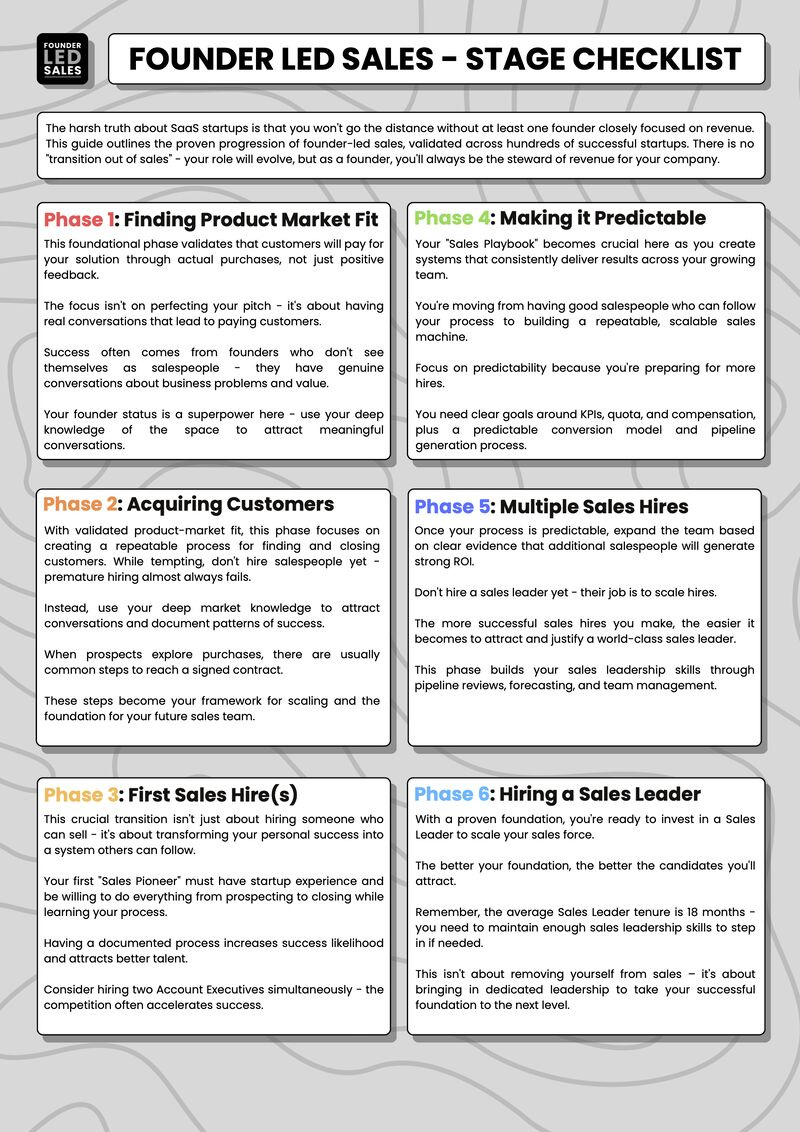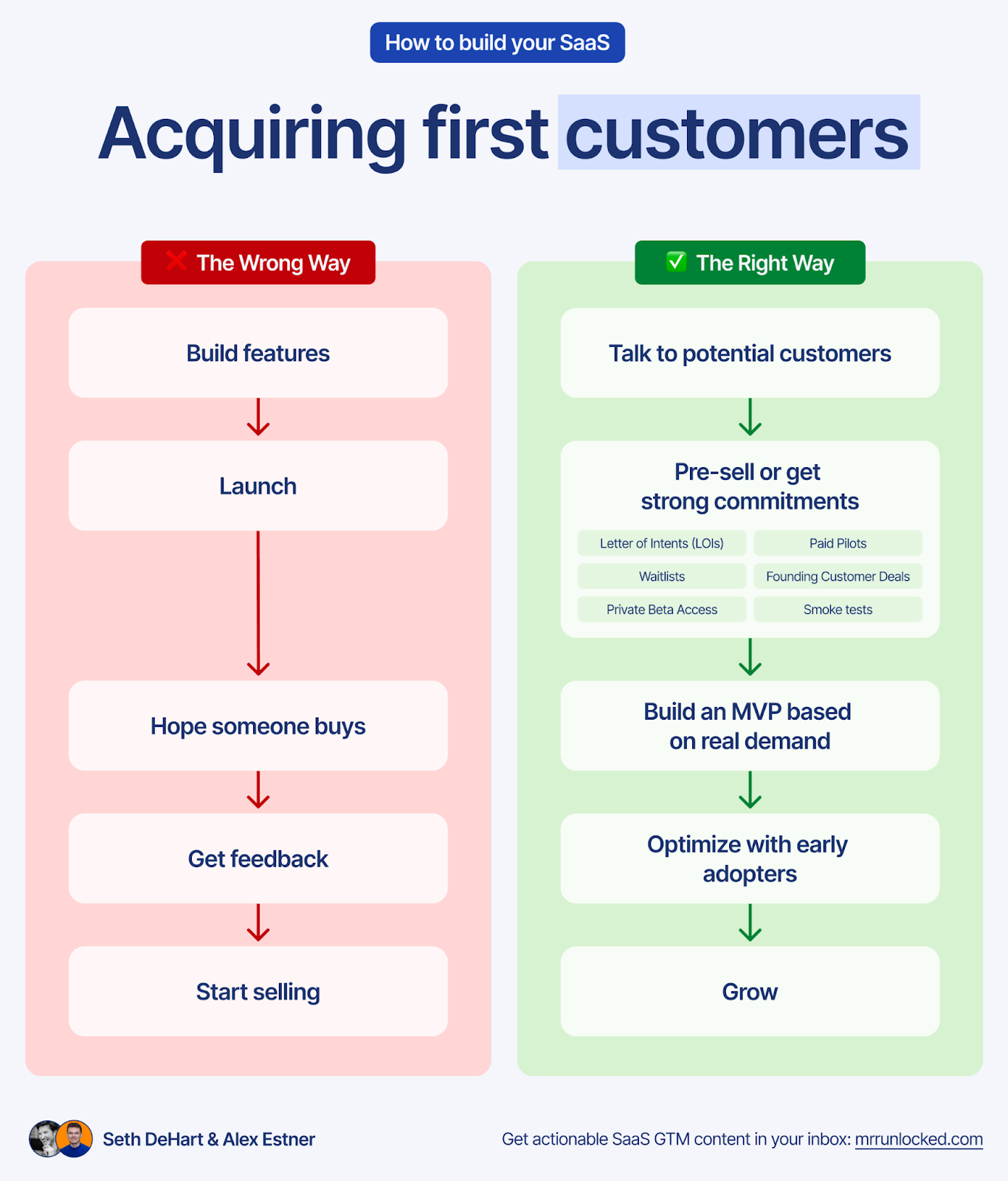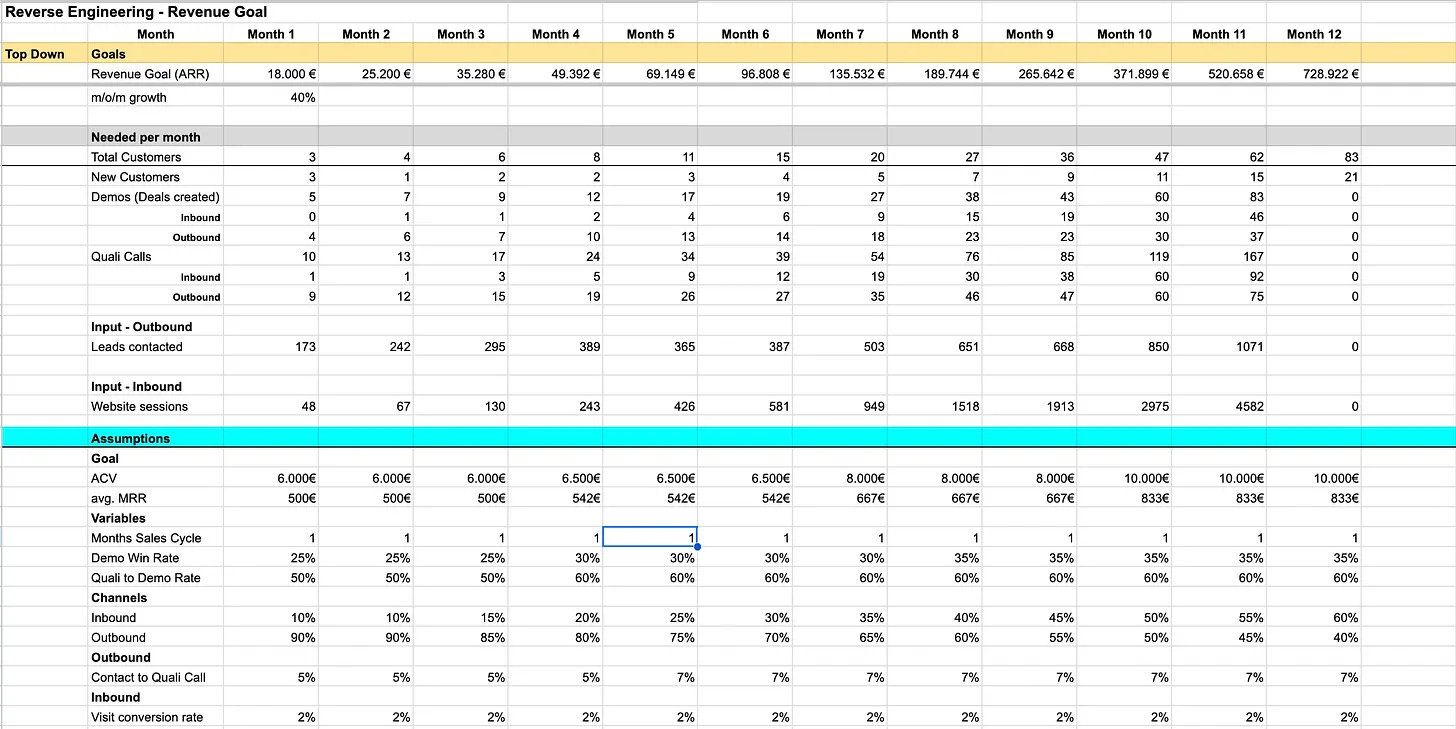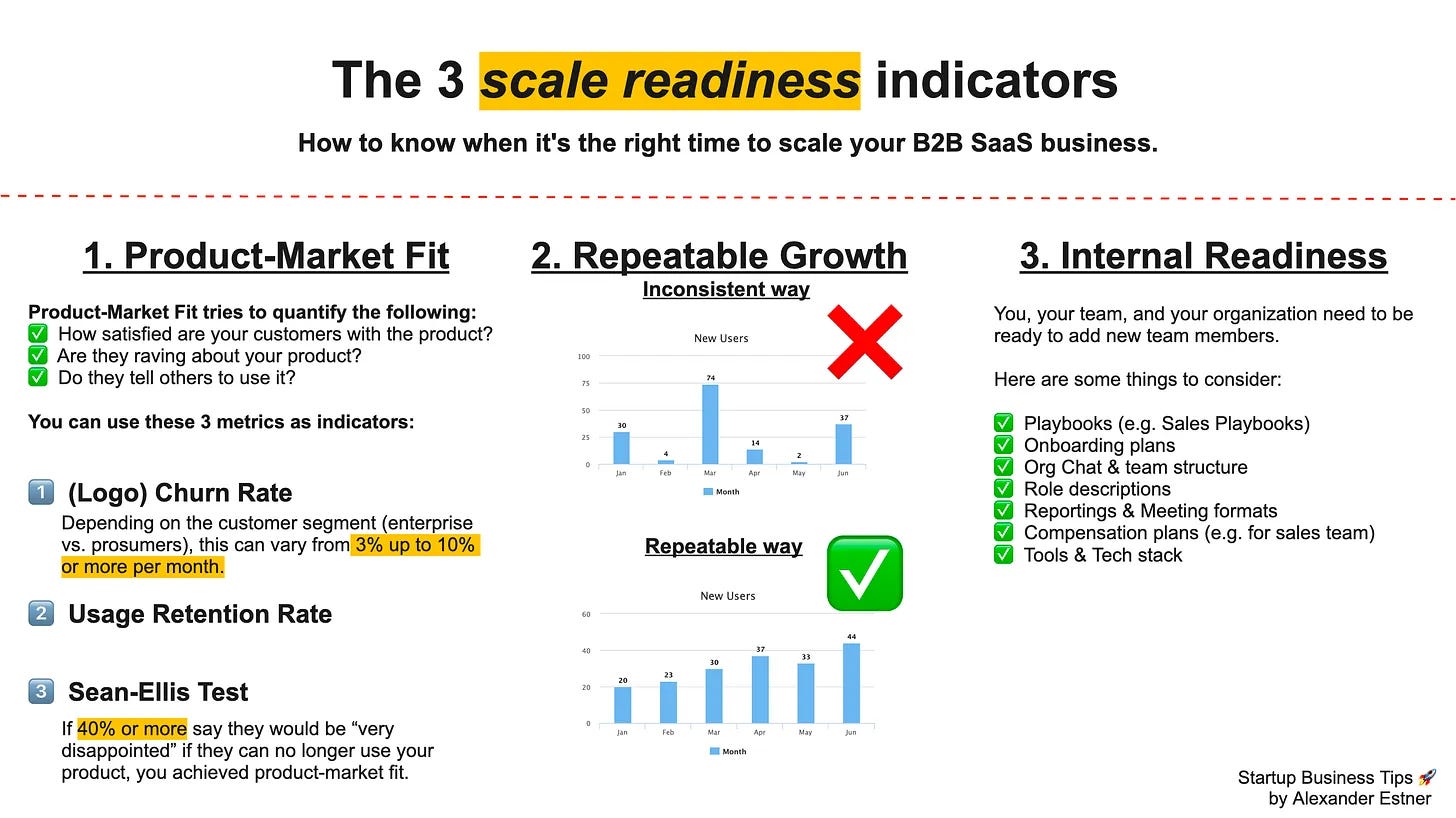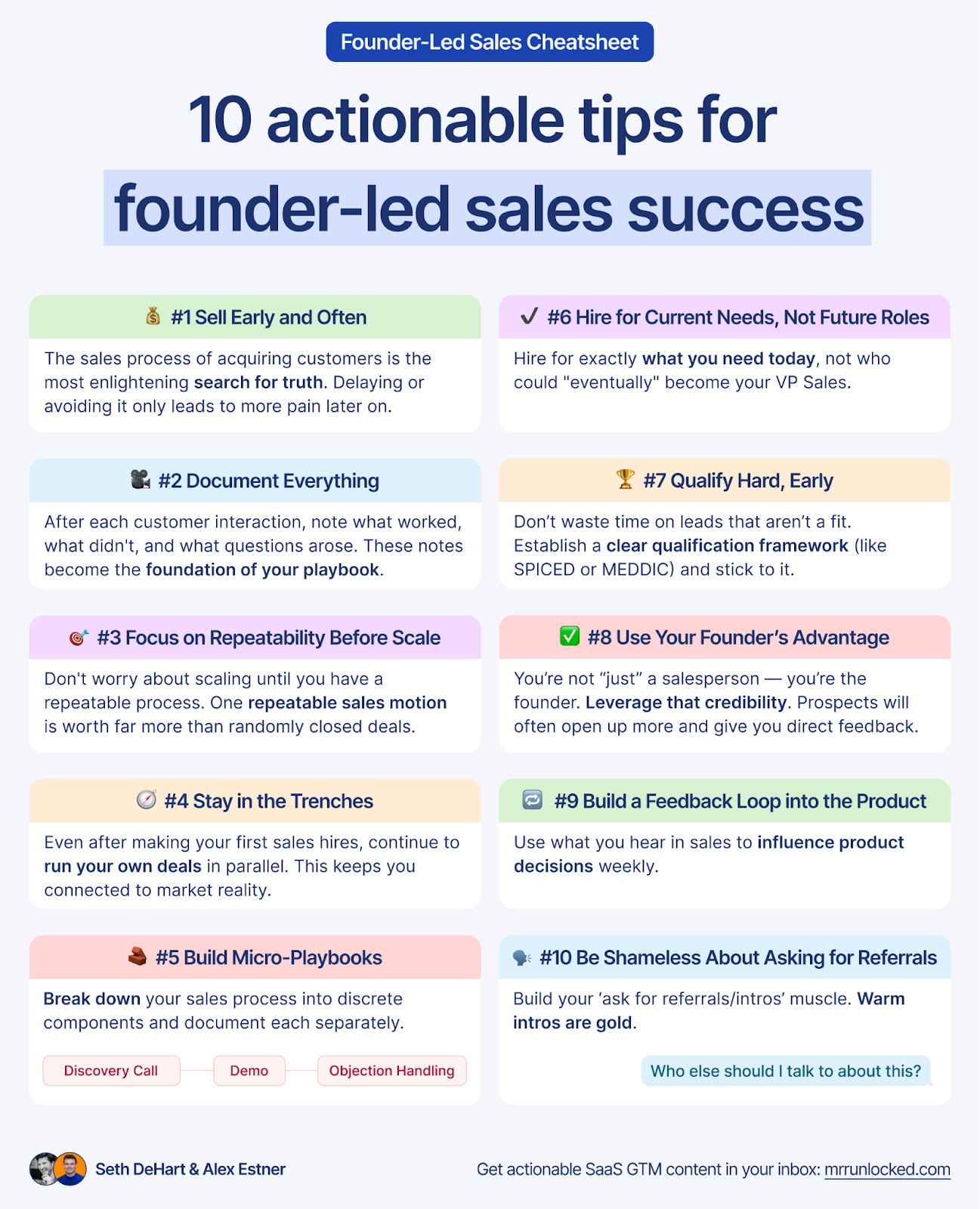Founder-Led Sales is Forever: The Ultimate Guide to Revenue Leadership
The 6 phases of founder-led sales
Hey - it’s Alex, this time together with Seth DeHart!
Today, we cover:
1️⃣ Why founder-led sales is the founder's permanent responsibility
2️⃣ The 6 phases of founder-led sales
3️⃣ 10 Actionable tips for successful founder-led sales
Top Links:
👉 Join the free founder-led sales platform to access the must-have resources to help you on your journey www.joinfounderledsales.com
👉 Work 1-on-1 with Alex to build and execute your GTM foundation
Bonus: List of my vetted Go-to software tools for early-stage SaaS startups
In case you missed the last 3 episodes:
✅ 10 GTM myths from €0 to €1 million ARR
✅ Hiring your first GTM team: 9 common mistakes
✅ Social Listening Guide: Identify high-intent mentions to grow your SaaS
A quick word from our sponsors
📢 Attio— The AI-native CRM that’s built for the future
Attio is the CRM for the AI era. Connect your email, and Attio instantly builds your CRM - with every company, every contact, and every interaction you’ve ever had, enriched and organized. Join industry leaders like Flatfile, Replicate, Modal and more.
Want to reach 4500+ early-stage SaaS founders/leaders? Sponsor the next newsletter.
The Most Dangerous Myth in Startup Land
There's a dangerous myth circulating among founders
"Once you reach €X in revenue, you can hand off sales to professionals and focus on being a real CEO."
This well-intentioned but catastrophically wrong advice has killed more promising startups than we can count.
Being involved in and being the steward of the revenue engine is a lifelong founding decision. One founder must always be involved.
👉 The Founder needs to be the Revenue Steward 👈
The fallacy that you transition out— it's very appealing for sales agencies, coaches, or advisors to sell to founders, because very few people want to do sales.
"I'll help you transition out of sales. Let's get you out of sales."
But as a founder, it’s an absolute necessity.
Seth has worked with 100+ founders and watched the rise (and fall) of countless B2B SaaS companies, It’s become clear that:
Founder-led sales isn't a phase you graduate from—it's a permanent responsibility.
What Is Founder-Led Sales, Really?
Founder-led sales isn't just about the founder personally closing deals (though it starts there).
It's about the founder driving the revenue engine for the entire existence of the company.
Yes, your role will evolve. Yes, you'll eventually build a team. But no, you should never fully disconnect from sales.
Think of it this way:
In the beginning, you're the engine.
Later, you're the engineer.
Eventually, you're the architect.
But you're always, ALWAYS responsible for ensuring the machine runs.
✅ It's certainly transitioning out of solo selling or founder selling,
❌ But not out of sales entirely.
Founders need to have a mindset that one person on the founding team will own that revenue forever, be deeply involved, and not try to get out of it.
Why Founders Must Own Go-To-Market Forever
The biggest killer of startups is a detachment from reality. It’s how promising startups die.
Founders who delegate sales too early find themselves completely disconnected from market reality.
They lose touch with critical market truths:
Are customers actually willing to pay for your solution?
Which features truly drive purchase decisions?
What objections consistently block deals?
Is the pricing aligned with perceived value?
Who do you compete most with (direct & indirect competition)?
Is your messaging still resonating with your ICP?
So when growth stalls, they lack the context to diagnose what's wrong.
❌ Founders with unreasonable expectations of their salespeople or sales leaders.
✅ A great leader is in touch with reality and has an understanding of what's going on.
So one more time: One Founder must own the go-to-market motion for a very long time.
In the search for product-market fit, you start to uncover unique aspects that allow for a go-to-market motion to be performed.
When you do outbound prospecting yourself, you understand nuances like
✅ The messaging needed to attract a prospect,
✅ What makes a good ICP & Buyer persona
✅ What they care about (Pain points, objections, critical events…)
Having someone else figure out these aspects increases the likelihood of failure because you are unclear about critical points like
What goals should you set for your business?
What is the best way to deploy resources?
Who is the best hire?
What should be your product roadmap?
All these things require the founder to be close to the metal, close to the action, steering from the source of truth, and it comes only from direct communication with the customer.
If there is anyone else between you (the founder) and the customers/prospects, you'll most likely receive biased information based on who's giving it to you.
For these reasons, the founder must be close to the go-to-market forever.
But the way you are responsible for sales will change over time.
So let’s have a closer look at the 6 phases of founder-led sales.
The Six Phases of Founder-Led Sales
As a founder, you will evolve in 6 phases:
1️⃣ Phase 1: Finding Product-Market Fit
2️⃣ Phase 2: Acquiring First Customers
3️⃣ Phase 3: Making Your First Sales Hire(s)
4️⃣ Phase 4: Making It Predictable
5️⃣ Phase 5: Multiple Sales Hires
6️⃣ Phase 6: Hiring a Sales Leader
Phase 1: Finding Problem-Solution Fit
You're personally validating that customers will pay for your solution. Without problem-solution-fit, there's nothing to sell, but the search for product-market fit inherently involves selling—you can't validate product-market fit without customers exchanging cash for your value.
→ As you know, Alex calls this phase ‘hustle-mode’.
Phase 2: Acquiring First Customers
Many founders make a catastrophic mistake here: they build first, then try to sell later. This inverts the natural order and usually leads to building features nobody wants to pay for.
Thinking about finding product-market fit without thinking about acquiring customers makes no sense.
The premise of "if we build it, then they will come" misses the point that if you're not out in front of the customers, understanding what to build, they won't come.
Technically, if you have one customer, you still have product-market fit, but it’s quite weak, so don’t start celebrating product-market fit too much until you have multiple customers.
The purest feedback on features comes from those willing to exchange cash for your value. Everything else is just speculation. Without someone willing to pay for those features is just ideas and not concrete evidence that people would actually be interested in buying.
❌ The wrong way
Build features → Launch → Hope someone buys → Get feedback → Start selling
✅ The right way
Start selling before your product is fully built. Or better yet - build while you sell.
Talk to potential customers → Pre-sell or get strong commitments → Build an MVP based on real demand → Optimize with early adopters → Grow
Building in a vacuum is a startup killer.
Build with your market, not for it.
Getting early commitments can be:
Letter of Intent (LOIs)
Paid Pilots
Design Partner Agreements
Founding Customer Deals
Waitlists
Private Beta Access
Smoke tests
Yes, you'll need some MVP to show them, but there's no reason to delay acquiring customers when the most critical part of the company is product-market fit, and strong product-market fit means that there are clients pulling the product and a massive need being filled.
Typically, customer acquisition is scary because it requires hearing the truth from clients, telling you your baby is ugly. But the sooner that happens, the better. The sooner you'll be able to iterate, build the features needed that clients will pay for.
This being said,
Acquiring customers as the founder is the absolute most important step in the early days of the company.
You're personally closing deals and beginning to recognize patterns in what works. You are acquiring customers for the purpose of learning, until the process becomes repeatable.
This is where you develop lightweight "micro-playbooks" that can eventually be taught.
→ This phase is not about scaling.
It mostly is about doing non-scalable things to learn and get 1-2 channels performing.
Curious to learn how? Check out 9 tactics to get your first 50 customers in 2025.
That entire process becomes the backbone of the company. If there is repeatability, and you get to the point where, with more horsepower, you can accelerate that repeatability, that's when you get into Phase 3, where you're making your first sales hire(s).
Phase 3: Making Your First Sales Hire(s)
The most misunderstood phase in the journey is the first sales hire.
Too many founders see this as their escape hatch from sales - they make the first sales hire incorrectly based on wanting to get out of sales. That's when they often make too senior of a hire, and they f*** it up.
You don't make your first sales hire to get out of sales. You make it to supplement and accelerate what's already working because you are at capacity.
This isn't a "get out of sales" move. You never transition out of sales. You transition out of solo selling. You never really transition out of being the leader of the revenue organization, because whatever happens, it's the CEO's responsibility for revenue.
So the founder stays involved in sales forever.
When to hire?
Some people say you should be the only seller until you're up at €1 million ARR.
While we could discuss if this is the right threshold, it’s a good mindset to have, because it sets the expectation that you need to close a lot of deals before you think about making a first sales hire. And it goes without saying that your customers need to be happy with the product and stick around without churning before thinking of adding more horsepower to customer acquisition.
The right time to make this hire isn't based on some arbitrary revenue number. It's when:
You have a repeatable way to acquire customers (and keep them)
You're capacity constrained ("If I just had more time, I could close more deals")
You can clearly articulate the pattern that's working
So the most common mistakes we see in this phase are:
❌ Hiring too early (before you find patterns that are working)
It's critical to know that repeatability is essential to make a first sales hire successful.
If you can't repeatedly acquire customers, you might not have product-market fit, and you certainly don't have Go-To-Market fit. So you need to go back to the previous phases before you get here.
❌ Hiring a sales leader as your first hire
A sales leader, by nature, is someone who's managing people, not someone who's managing sales opportunities/deals.
If you're hiring a sales leader as your first sales hire, you're extricating yourself from sales, from being close to the truth. You're putting a buffer between the founder and the truth, and you will likely fail. If you’re thinking about managing risk, this is the riskiest thing you can do.
Instead, bring on a hands-on sales Swiss Army knife - Seth likes to call them a "Sales Pioneer"—a rare breed with a specific set of attributes. It's in fashion to call it a "founding account executive" (sounds sexy) or a "go-to-market account executive" (also sounds sexy).
Your Sales Pioneer isn't your average Account Executive. It's an account executive who has some specific qualities that make them a pioneer.
❌ Hiring the wrong profile (no sales pioneer)
You bring on a "Sales Pioneer" to supplement (not replace) your selling efforts. You're still deeply involved in sales, now with added bandwidth. The key to this phase is having some repeatability in finding those first few customers.
You're only making a sales hire because you need to supplement and accelerate the repeatability of acquiring customers.
In our recent newsletter, we talked about the characteristics of the Sales Pioneer.
But Seth added a few good additions, so here is the combined list now.
Sales Pioneer Characteristics
✅ Startup Experience
✅ Strong Prospecting Skills
✅ Proven Closing and pipeline-building experience
✅ Full Cycle Experience
✅ Is a Challenger Seller
✅ Entrepreneurial Spirit (get shit done mentality)
✅ Has grit, adaptability, and a strong work ethic
✅ Builder mentality - strong willingness to build, test, and execute
✅ High IQ
Bonus one:
✅ The Hunger Factor
And then there's the top 1% that have the crazy factor, where they have a chip on their shoulder.
Whatever goals you set for them, it's never enough. They're the ones who usually double up with their peers whenever they're on a team. They are very rare.
Phase 4: Making It Predictable
With your first hire(s) in place, you focus on creating a truly predictable process with clear KPIs and conversion metrics. You need to understand factors like
HOW many prospects need to be entered into a cadence
⬇️
To generate HOW many discovery calls,
⬇️
To get how much pipeline and opportunities,
⬇️
To produce HOW much revenue in WHAT time
You start to make your GTM predictable and can answer:
✅ Your MQL to SQL conversion rate
✅ Your SQL to customer conversion rate (deal win rate)
✅ Your sales cycle
✅ Your average contract value (ACV)
The more predictable it is, the greater the likelihood that the first sales hire(s) will be successful. You can also develop sales methodologies that work for your specific business during this phase.
The goal is to come up with a sales forecast that allows you to exactly know what you need to hit on a daily, weekly, monthly, and quarterly basis to hit your next revenue milestone. (reverse engineering sales plan)
Phase 5: Multiple Sales Hires
Once your process is repeatable and predictable, you can confidently bring on additional salespeople who can succeed within your established framework.
→ Your goal is to have repeatability and predictability to scale.
Phase 6: Hiring a Sales Leader
The right time to hire a sales leader is when you already have a handful of people on the sales team who are executing.
If you have 2, 3, or 4 account executives, 1, 2, 3, or 4 SDRs producing, then it's very easy to attract a world-class sales leader.
But you, the founder/CEO stay the CRO, no matter what, always managing that sales leader.
The critical insight here is that by following this progression in order, you become a competent sales leader yourself before hiring one.
By the time you get to the point that you can hire a sales leader, you have a good idea of what the job entails, and you'll know exactly what good performance looks like because you've been doing the job.
And now you're going to be handing the reins over to a VP of Sales, but you're going to ease out of that while they take over.
This phase is very risky, because you will be handing over and stepping away. The natural tendency will be to step away completely, but that is not ideal for the business.
Stay close to the VP Sales, manage them tightly, and be their teammate for a long time.
10 Actionable Tips for Founder-Led Sales Success
1. Sell Early and Often
The sales process of acquiring customers is the most enlightening search for truth. Delaying or avoiding it only leads to more pain later on.
2. Document Everything
After each customer interaction, note what worked, what didn't, and what questions arose. These notes become the foundation of your playbook.
3. Focus on Repeatability Before Scale
Don't worry about scaling until you have a repeatable process. One repeatable sales motion is worth far more than randomly closed deals.
4. Stay in the Trenches
Even after making your first sales hires, continue to run your own deals in parallel. This keeps you connected to market reality.
5. Build Micro-Playbooks
Break down your sales process into discrete components (discovery call, demo, objection handling) and document each separately.
6. Hire for Current Needs, Not Future Roles
Hire for exactly what you need today, not who could "eventually" become your VP Sales.
7. Qualify Hard, Early
Don’t waste time on leads that aren’t a fit. Establish a clear qualification framework (like SPICED or MEDDIC) and stick to it.
8. Use Your Founder’s Advantage
You’re not “just” a salesperson — you’re the founder. Leverage that credibility. Prospects will often open up more and give you direct feedback.
9. Build a Feedback Loop into Product
Use what you hear in sales to influence product decisions weekly.
10. Be Shameless About Asking for Referrals
Build your ‘ask for referrals/intros’ muscle: “Who else should I talk to about this?” Warm intros are gold.
Summary- Embracing the Truth
We know this isn't what most founders want to hear.
Technical founders especially often hope to build a great product, hire salespeople, and return to product development.
But embracing the permanent nature of founder-led sales isn't a burden—it's a competitive advantage.
The founders who accept this reality build stronger companies, with more resonant product roadmaps, more effective go-to-market strategies, and more resilience during inevitable setbacks.
Coming into any of this thinking, "Hey, I'm going to figure out a way out of sales" already sets up the business for failure.
It's natural to try to get out of sales. It's painful. The rejection is brutal and honest. The prospect often does not want to exchange their money for your value. But that reality and that truth are what keep the startup honest, keep the revenue engine honest, keep the business honest.
And that's why a founder must be involved in the go-to-market motion via founder-led sales for the entire existence of the startup.
The most successful founders made peace with their permanent role in sales. They don't see it as a distraction from their "real job"—they recognize it as an essential component of their real job.
After all, without revenue, nothing else in your startup matters.
Get the support you need for your Founder-Led Sales Journey
Now you know everything about the founder-led sales journey. Seth and I have two offers that will support you in the best way on your founder-led sales journey:
1️⃣ Join 600+ Founders on the free founder-led platform www.joinfounderledsales.com - it comes with a resource library of 70+ guides for founders seeking sales strategies, hiring tips, and growth playbooks.
2️⃣ Work 1-on-1 with Alex to build and execute your GTM foundation. For founders on their journey from €0 to €1 million ARR. Book a free intro call (limited to max. 6 founders)
Happy growth 🚀
3 ways I can help you grow your SaaS to €1 million ARR 👇
1️⃣ Build your SaaS GTM strategy with my free Workbook (helped 5000+ SaaS leaders)
2️⃣ Get access to 100+ actionable SaaS growth tactics (helped 250+ SaaS leaders)
3️⃣ Work 1-on-1 with me - GTM Advisory for SaaS founders from 0€ to €1 million ARR






